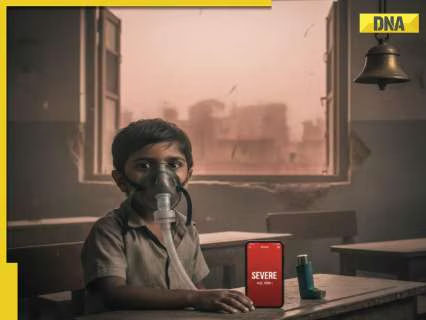
Every 3 minutes, India loses a child under five to toxic air. Every hour, the same air accelerates someone’s slide into dementia. This isn’t a forecast; it’s a funeral march in slow motion.
When you open the window in North India between October and January, you’re not letting in fresh air, you’re letting in a silent killer. The school bell rings in empty classrooms. Parents refresh air quality apps like stock tickers. The “Severe” warning glows red, and childhood fades behind inhalers and oxygen masks. This isn’t just about Delhi. This is a nationwide emergency that has become both a health tragedy and a policy failure.
A Nation on Life Support: The Devastating Cost of Dirty Air
India’s air is among the most dangerous in the world. According to the 2024 World Air Quality Report, India’s average PM2.5 levels were 10x higher than WHO guidelines and the country claimed 6 of the 9 most polluted cities on Earth. The particles in our air are not harmless dust. PM2.5 slips past every defence in our lungs, lodges in our bloodstream, and ignites a chain reaction-damaging hearts, brains, and even unborn children. In 2021 alone, air pollution killed over 1.8 million Indians, including 169,400 children under five that’s 464 deaths per day, or one child every 3 minutes. India also accounts for nearly 50% of global ozone-related deaths, caused by a lungscorching gas that peaks on hot, stagnant days.
The Hidden Impact: Air That Makes Us Forget
This crisis isn’t just skin-deep or lung-deep. It’s brain-deep. Recent studies have shown that prolonged exposure to polluted air alters the development of the brain’s white matter in children, reduces memory retention, lowers academic performance, and increases the risk of early-onset dementia in adults. Microscopic particles penetrate the blood-brain barrier, silently degrading the mind over years. But there’s hope: clean air doesn’t just halt this damage, it reverses it. Brain scans from cleaner areas show reduced dementia markers. Less PM2.5 = more cognitive clarity.
Why Is India’s Air So Toxic?
The problem is multi-layered and man-made.
1. Coal Still Rules In 2024–25, over 75% of India’s electricity came from fossil fuels, with coal doing most of the work. While India crossed 50% non-fossil capacity in 2025, actual generation still relies heavily on dirty energy. Most coal plants still don’t have functional flue-gas desulfurization units, and sulphur dioxide continues to poison the skies.
2. Cities Are Gas Chambers Construction dust, diesel generators, open waste burning, and unregulated vehicles turn cities into smog bowls. Poor urban planning meets apathy, and children pay the price.
3. Winter Inversion Trap Every winter, polluted air gets trapped near the ground due to temperature inversion. Add crop burning in Punjab, Haryana, and UP, and you have a perfect storm. PM2.5 levels regularly spike beyond 400–500 AQI, a zone labelled “hazardous” even for healthy adults.
The Economic Catastrophe Few Are Talking About
Air pollution doesn’t just rob breath, it robs GDP. A World Bank-backed study estimated that air pollution cost India about 1.3% of GDP in 2019 – ₹2.9 lakh crore ($37 billion) from healthcare costs and productivity losses. More disturbingly, if India had halved its air pollution over the past generation, it would have been measurably richer, with better-educated children, fewer lost workdays, and sharper cognitive performance across generations.
Clean Air = National Growth Policy
If Delhi met the WHO’s clean air standards, residents could gain up to 8 additional years of life. Across India, the average person could gain 2–4 years. That’s not just lifespan, it’s economic life, mental health, and educational potential. Clean air isn’t a luxury. It’s the most urgent early childhood intervention, mental health program, and economic stimulus plan this country needs. India’s Clean Air Reset: From Protest to Policy We don’t need more promises. We need proof. And the science is clear-cleaner air saves lives within weeks, not years.
Here’s how we fix what’s broken, not in theory, but in practice: • Only 1 in 10 coal plants in India has a functioning sulphur scrubber. That’s not just data it’s 500,000 avoidable deaths waiting to happen over the next decade. • Over ₹6,000 crore under the National Clean Air Programme lies unspent across cities. Meanwhile, paediatric ICUs are full every winter. • 25 crore vehicles still spew toxins daily. Only a fraction is checked. Most children walk to school breathing diesel dust, while we talk about EV targets. • Crop burning spikes PM2.5 levels by 300% on some days, yet machines and money don’t reach farmers in time. • On worst-air days, we react late, shutting schools after the damage is done, without masks, filters, or a plan. We must stop treating clean air as a seasonal inconvenience. It is a constitutional right, an economic opportunity, and above all, a moral duty.
From Inhalers to Hope: What Must Change Immediately
• Make every thermal plant disclose its pollution record publicly. • Link clean-up to power dispatch: no scrubbers, no merit order. • Subsidize LPG where coal and wood still choke kitchens. • Clean air zones around all schools and hospitals, no diesel, no dust. • Guarantee crop-residue solutions before harvest season, not after. • Trigger school-level safety plans when AQI hits “very poor” automatically. This is not a wish list. These are urgently doable, data-backed interventions. Not for 2030, but before the next winter.
Treat This Like a Mission, Not a Memo
Cleaner air = higher IQ + longer life + richer GDP. We do not need more vision documents. We need visible skies. We do not need another “pilot project.” We need a national mission with the urgency of infrastructure, elections, or war rooms. The proof? Every gigawatt of clean energy installed, every city that enforces a ban, and every coal plant cleaned up translates into real faces saved children who can laugh without wheezing, elders who can remember names, workers who do not miss a month of income.
A New November Is Possible
In July 2025, Delhi recorded one of its cleanest monsoons in a decade. That proves progress is possible. Every solar rooftop, every biogas plant, and every clean cooking connection is a step toward reclaiming childhood. But the most compelling reason to act is not a chart or study. It’s the child coughing at the school gate, the grandmother who forgets names too soon, the teen missing exams due to an asthma attack. We don’t need another committee. We need urgency. Every breath matters. Every life counts. • 464 children under 5 die every day in India due to air pollution. • Dementia risk climbs with every season of smog. • India loses ₹2.9 lakh crore every year due to air-related productivity and health costs. • Clean air could boost GDP, school performance, and brain health. India’s children don’t deserve to remember November as the month of inhalers. They deserve picnics, kites, and clean skies. If clean air becomes a national mission, we won’t just save lungs, we’ll save futures.





